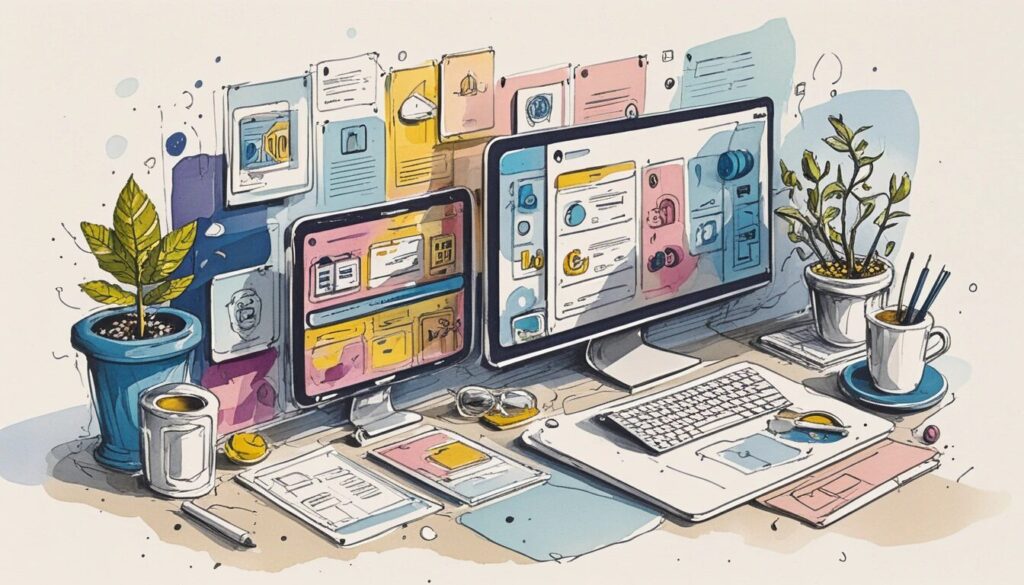UI Design in 2025: A Revolution You Didn’t See Coming
Remember when digital interfaces were just a collection of dull rectangles and uninspired gradients? Well, those days are as outdated as dial-up internet. Welcome to 2025, where UI design isn’t just evolving—it’s transforming into an experience so immersive, you might forget reality exists.
From Mobile UX Design Trends 2025 to the rise of Interactive 3D UI Elements, the digital landscape is undergoing a radical shift. Artificial intelligence is shaping interfaces that think for you, while design aesthetics are embracing depth, motion, and even a touch of nostalgia with Modern Skeuomorphism in Digital Design. Let’s explore the UI trends that are set to dominate this year and why users will fall in love with them.
Interactive 3D UI Elements: The Death of Flat Design
- Deeper engagement: Users interact with elements rather than passively clicking.
- Realism meets functionality: 3D design adds depth, making interfaces feel more tangible.
- Seamless AR/VR integration: Digital experiences blur the boundaries between virtual and real.
Let’s be honest—flat design had a good run, but it’s about as exciting as watching paint dry. Enter Interactive 3D UI Elements, where interfaces aren’t just visually appealing—they’re alive. Buttons morph with your touch, product previews rotate on command, and immersive storytelling becomes the new norm.
Thanks to WebGL and improved browser support, 3D elements are no longer clunky distractions. They now serve a functional purpose, enhancing e-commerce, education, and even social media engagement. Whether it’s a sneaker that spins with a flick or an interactive city map, 3D is making interfaces feel like a playground rather than a chore.
AI in User Interface Design: When Your UI Knows You Better Than You Do
- Hyper-personalization: AI tailors UI elements based on user habits.
- Dynamic content layouts: Interfaces shift and adapt in real time.
- AI-driven aesthetics: Subtle design cues indicate machine-generated content.
Artificial intelligence isn’t just lurking in the background anymore—it’s taking over UI design, and frankly, it’s about time. AI in User Interface Design means interfaces that adapt to your behavior, serving up the content you need before you even realize you need it.
Take Google’s NotebookLM, for example, which dynamically generates study notes, or IBM’s Carbon Design System, which subtly marks AI-generated content with gradient indicators. Even voice assistants like Siri and Alexa are integrating visual cues to make AI interactions feel more human. The future isn’t just smart—it’s intuitive.
Progressive Blur Techniques in UI: Clarity Through Softness
- Guided focus: Directs attention to key elements without visual clutter.
- Layered depth: Creates visual hierarchy without overwhelming users.
- Seamless transitions: Enhances fluidity between UI elements.
Blurring used to be an unfortunate camera mishap. Now, it’s a design revolution. Progressive Blur Techniques in UI are redefining readability, focus, and aesthetics by softening the right elements at the right time.
Instead of clunky overlays that obscure half the screen, progressive blurs create elegant transitions, ensuring users stay focused without feeling overwhelmed. Hover over a menu, and background elements fade into a delicate blur, drawing attention exactly where it belongs. It’s a simple touch that makes a world of difference—especially in mobile UX, where screen real estate is precious.
Modern Skeuomorphism in Digital Design: Retro, But Make It Chic
- Soft realism: A refined, minimalist approach to skeuomorphism.
- Tactile aesthetics: Subtle shadows and textures enhance digital interactions.
- Perfect for AR/VR: Bridges the gap between physical and digital experiences.
Ah, skeuomorphism. The design trend that once gave us stitched leather textures and faux-wood panels is making a comeback—but this time, it’s tasteful. Modern Skeuomorphism in Digital Design blends realism with minimalism, bringing back depth and tactility without the visual clutter.
Why the resurgence? As AR and VR become mainstream, flat design just doesn’t cut it anymore. Users want interfaces that feel natural, and modern skeuomorphism delivers that through soft shadows, subtle textures, and just enough realism to make digital buttons feel physically pressable. It’s like nostalgia, but without the cringe.
Zero UI: The Interface That Disappears
- Gesture navigation: Less tapping, more intuitive movement.
- Voice-first interactions: UI elements respond to speech commands.
- Embedded technology: Digital experiences blend into the physical world.
What if the best UI was no UI at all? Zero UI is pushing interfaces beyond screens, integrating voice and gesture controls into everyday interactions. It’s the difference between tapping through menus and simply saying, “Turn on the lights.”
With wearable technology on the rise, users are demanding seamless experiences that feel organic rather than forced. Whether it’s smart home systems responding to your voice or AR glasses overlaying digital information in real-time, UI design is moving toward something less visible—but infinitely more powerful.
The UI Revolution Is Here—Are You Ready?
User interface design in 2025 isn’t just about aesthetics—it’s about experience. Interactive 3D UI Elements are making digital environments feel tangible, AI in User Interface Design is crafting interfaces that think for us, and Progressive Blur Techniques in UI are refining visual hierarchy. Meanwhile, Modern Skeuomorphism in Digital Design is bringing back depth with sophistication, and Zero UI is proving that sometimes, the best interface is the one you don’t even notice.
The future of UI is immersive, intelligent, and intuitive. So, the question is: Are you adapting, or are you still clinging to flat, lifeless screens? The digital world is evolving—don’t get left behind.
